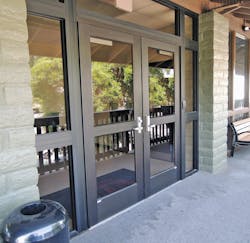Contactless Power Transfer With the Securitron® PowerJump™
Let's face it, running wire from the jamb to the door lock mechanism is not always fun. Over the years, the task has become easier with the development of power transfer devices using controllable Bellhanger's Bits, fiberglass rods and door coring tools.
Before the introduction of the Securitron® PowerJump™, no manufacturer has developed a saleable product that can transfer 12 or 24VDC power from the swing or hinge side, the top or bottom of a door to the lock mechanism without physical contact.
The Securitron PowerJump patent number 8,294,302 relies on inductive coupling power transfer (ICPT). This "contact free and wireless" transfer mechanism provides up to 500mA@12VDC or 250mA @24VDC at the door. The voltage is set at the door unit.
To describe the operation of inductive coupling power transfer, Securitron uses the example of the electric toothbrush, which sits on the power supply to be charged. There is no direct electrical contact. The power moves from the charger through two plastic housings into the toothbrush battery. A post on the battery charger slides into the opening in the brush assembly to ensure proper alignment.
Inductive coupling is the result of magnetic fields generated during the flow of electricity within a wire coil. When fluctuating power is applied to a coil, a changing magnetic field is created. The power within this magnetic field can be induced to transfer to another exact frequency coil in range, providing contactless low voltage transfer of power. The range of the induced field is limited by the wavelength. For the Securitron PowerJump, the range is approximately 3/16" between the frameside unit face and the doorside unit face.
Because this dimension is larger than the gap between a door and the jamb, the frame unit can be installed into the hinge or lock side of the jamb or into the header. The door unit is then installed into the door.
To gain the maximum amount of amperage, alignment of the door and frame units is critical. They must be horizontally and vertically aligned. If there is significant misalignment, the power will not transfer. They must be directionally within less than 3/16" directionally of each other to transfer power.
The PowerJump can be used to power electrified door lock hardware that requires up to six watts (0.5A@12VDC). The PowerJump was designed for Fail Secure devices.
Installation
For the purpose of this article, we installed the Securitron PowerJump into the right leaf of a double medium stile aluminum glass door entry. Both of the doors are equipped with mid rails, each having two glass panes. Both of the outswing doors were mounted using aluminum continuous hinges. Each is equipped with a Sargent 8800 rim exit device. A removable mullion provides the latching for the exit devices.
Note: Power was shut off to this opening.
The right door is equipped with the Sargent 774ETL exterior trim with the "L" lever. This solenoid controlled trim provides remote locking and unlocking of the exterior lever. This Fail Secure trim was ordered with a 24VDC solenoid operating at 250mA. The left door is equipped with the Sargent 704 ETL key override rim cylinder in the exterior trim.
The original installation specified a surface door cord to transfer power from the jamb to the door. The installation of the PowerJump was necessary because the door cord was being vandalized, disabling card access and requiring a key to gain entry. Installation of the Securitron PowerJump did away with the exposed wiring, eliminating the problem.
To keep things simple, we decided to locate the PowerJump on the hinge side of the door at about the same height as the door loop. This proved advantageous since the thickness of the continuous hinge leaf is approximately the same as the thickness of the PowerJump face. No mounting tabs were necessary because the PowerJump could be mounted directly onto jamb.
The template was positioned onto the jamb side of the continuous, offset to be as close to the middle of the door edge. The continuous hinge is wider than the door as the gear cap and a portion of the leafs are exposed.
Measurements were taken from above the door to determine the centerline. This measurement was transferred to the jamb. The amount of space was somewhat limited and a decision was made to cut the opening for the frame unit first.
There are two sets of dimensions for the PowerJump using this method of installation, body dimensions and face dimensions. Body dimensions are 1-7/8" tall by 1-1/4" wide. These cutouts in both the hinge and the jamb will create the opening necessary for insertion of the frame unit and door unit. The face dimensions are 2-3/4" tall by 1-1/4" wide. Only the continuous hinge will have to be cut in order to recess the face, which is 1/8" thick.
Once the template was positioned, four 5/16" diameter holes were drilled at the corners through the continuous hinge and the jamb. Because of the confined work area, a jigsaw could not be used. Instead, we used a rotary tool with a cutoff blade to cut both layers from drilled hole to drilled hole.
Once the hole was cut, filed and de-burred to accommodate the PowerJump frame unit body, the face opening had to be cut. The opening was cut along the template lines through the continuous hinge. We dry mounted the frame unit to be certain it fit the opening.
The wiring was cut and the door loop was removed. Using a bent piece of coat hanger, the wire was pulled through the jamb opening. To ensure solid contact, two wire Molex connectors were attached to the wiring supply to the jamb and the purple and black wires of the frame unit.
The frame unit was installed into the jamb using the supplied screws. To ensure alignment, a dab of putty was placed at the centers of the two Phillips Head screws. Closing the door, a bit of the putty transferred onto the door side of the continuous hinge. These two indicators and the top and bottom of the frame unit provided positioning for the door unit template.
The four corners were drilled and the rotary tool was used to cutout the openings. A file was used to make adjustment and clean up the opening. The wiring was pulled from the rail out of the cutout. Molex connectors were installed and the door unit was installed.
Once the wiring was completed and the door unit installed, power was activated. A valid card was presented to the reader. The reader illuminated green and a click could be heard. The door was pulled open by the handle. This test was repeated several times to ensure smooth operation.
The door cord holes were sanded and filled with body putty. After drying, the body putty was sanded smooth and spray painted with touchup paint.
The Securitron PowerJump can be installed along just about any location on a door. This will make wiring easier for door locking hardware that requires 250mA@24VDC or 500mA@12VDC or less.
The Securitron PowerJump is covered by the MagnaCare Lifetime Replacement No Fault Warranty. For more information, visit www.securitron.com.
To read additional Locksmith Ledger articles about Securitron products, visit http://tinyurl.com/securitron813.
About the Author

